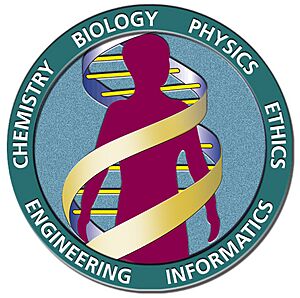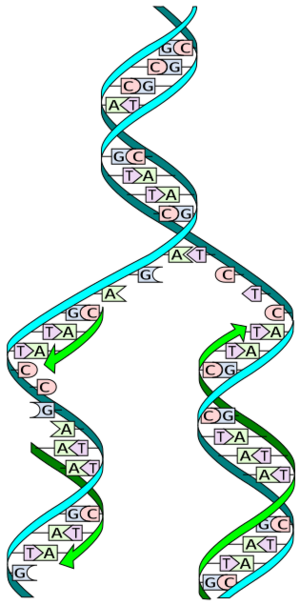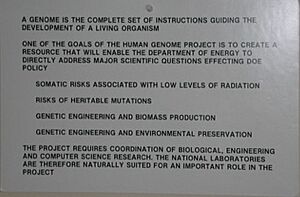Human Genome Project facts for kids
The Human Genome Project (HGP) was an international scientific research project with the goal of determining the base pairs that make up human DNA, and of identifying, mapping and sequencing all of the genes of the human genome from both a physical and a functional standpoint. It started in 1990 and was completed in 2003. It remains the world's largest collaborative biological project. Planning for the project started after it was adopted in 1984 by the US government, and it officially launched in 1990. It was declared complete on April 14, 2003, and included about 92% of the genome. Level "complete genome" was achieved in May 2021, with only 0.3% of the bases covered by potential issues. The final gapless assembly was finished in January 2022.
Funding came from the United States government through the National Institutes of Health (NIH) as well as numerous other groups from around the world. A parallel project was conducted outside the government by the Celera Corporation, or Celera Genomics, which was formally launched in 1998. Most of the government-sponsored sequencing was performed in twenty universities and research centres in the United States, the United Kingdom, Japan, France, Germany, and China, working in the International Human Genome Sequencing Consortium (IHGSC).
The Human Genome Project originally aimed to map the complete set of nucleotides contained in a human haploid reference genome, of which there are more than three billion. The genome of any given individual is unique; mapping the human genome involved sequencing samples collected from a small number of individuals and then assembling the sequenced fragments to get a complete sequence for each of the 23 human chromosome pairs (22 pairs of autosomes and a pair of sex chromosomes, known as allosomes). Therefore, the finished human genome is a mosaic, not representing any one individual. Much of the project's utility comes from the fact that the vast majority of the human genome is the same in all humans.
History
The Human Genome Project was a 13 year-long publicly funded project initiated in 1990 with the objective of determining the DNA sequence of the entire euchromatic human genome within 13 years. The idea of such a project originated in the work of Ronald A. Fisher, whose work is also credited with later initiating the project.
In May 1985, Robert Sinsheimer organized a workshop at the University of California, Santa Cruz, to discuss the feasibility of building a systematic reference genome using gene sequencing technologies. In March 1986, the Santa Fe Workshop was organized by Charles DeLisi and David Smith of the Department of Energy's Office of Health and Environmental Research (OHER). At the same time Renato Dulbecco, President of the Salk Institute for Biological Studies, first proposed the concept of whole genome sequencing in an essay in Science. The published work, titled "A Turning Point in Cancer Research: Sequencing the Human Genome", was shortened from the original proposal of using the sequence to understand the genetic basis of breast cancer. James Watson, one of the discoverers of the double helix shape of DNA in the 1950s, followed two months later with a workshop held at the Cold Spring Harbor Laboratory. Thus the idea for obtaining a reference sequence had three independent origins: Sinsheimer, Dulbecco and DeLisi. Ultimately it was the actions by DeLisi that launched the project.
The fact that the Santa Fe Workshop was motivated and supported by a federal agency opened a path, albeit a difficult and tortuous one, for converting the idea into public policy in the United States. In a memo to the Assistant Secretary for Energy Research Alvin Trivelpiece, then-Director of the OHER Charles DeLisi outlined a broad plan for the project. This started a long and complex chain of events which led to approved reprogramming of funds that enabled the OHER to launch the project in 1986, and to recommend the first line item for the HGP, which was in President Reagan's 1988 budget submission, and ultimately approved by Congress. Of particular importance in congressional approval was the advocacy of New Mexico Senator Pete Domenici, whom DeLisi had befriended. Domenici chaired the Senate Committee on Energy and Natural Resources, as well as the Budget Committee, both of which were key in the DOE budget process. Congress added a comparable amount to the NIH budget, thereby beginning official funding by both agencies.
Trivelpiece sought and obtained the approval of DeLisi's proposal from Deputy Secretary William Flynn Martin. This chart was used by Trivelpiece in the spring of 1986 to brief Martin and Under Secretary Joseph Salgado regarding his intention to reprogram $4 million to initiate the project with the approval of John S. Herrington. This reprogramming was followed by a line item budget of $13 million in the Reagan administration's 1987 budget submission to Congress. It subsequently passed both Houses. The project was planned to be completed within 15 years.
In 1990, the two major funding agencies, DOE and the National Institutes of Health, developed a memorandum of understanding in order to coordinate plans and set the clock for the initiation of the Project to 1990. At that time, David J. Galas was Director of the renamed "Office of Biological and Environmental Research" in the U.S. Department of Energy's Office of Science and James Watson headed the NIH Genome Program. In 1993, Aristides Patrinos succeeded Galas and Francis Collins succeeded Watson, assuming the role of overall Project Head as Director of the NIH National Center for Human Genome Research (which would later become the National Human Genome Research Institute). A working draft of the genome was announced in 2000 and the papers describing it were published in February 2001. A more complete draft was published in 2003, and genome "finishing" work continued for more than a decade after that.
The $3 billion project was formally founded in 1990 by the US Department of Energy and the National Institutes of Health, and was expected to take 15 years. In addition to the United States, the international consortium comprised geneticists in the United Kingdom, France, Australia, China, and myriad other spontaneous relationships. The project ended up costing less than expected, at about $2.7 billion (equivalent to about $5 billion in 2021).
Two technologies enabled the project: gene mapping and DNA sequencing. The gene mapping technique of restriction fragment length polymorphism (RFLP) arose from the search for the location of the breast cancer gene by Mark Skolnick of the University of Utah, which began in 1974. Seeing a linkage marker for the gene, in collaboration with David Botstein, Ray White and Ron Davies conceived of a way to construct a genetic linkage map of the human genome. This enabled scientists to launch the larger human genome effort.
Because of widespread international cooperation and advances in the field of genomics (especially in sequence analysis), as well as parallel advances in computing technology, a 'rough draft' of the genome was finished in 2000 (announced jointly by U.S. President Bill Clinton and British Prime Minister Tony Blair on June 26, 2000). This first available rough draft assembly of the genome was completed by the Genome Bioinformatics Group at the University of California, Santa Cruz, primarily led by then-graduate student Jim Kent and his advisor David Haussler. Ongoing sequencing led to the announcement of the essentially complete genome on April 14, 2003, two years earlier than planned. In May 2006, another milestone was passed on the way to completion of the project when the sequence of the very last chromosome was published in Nature.
The various institutions, companies, and laboratories which participated in the Human Genome Project are listed below, according to the NIH:
| No. | Nation | Name | Affiliation |
|---|---|---|---|
| 1 | The Whitehead Institute/MIT Center for Genome Research | Massachusetts Institute of Technology | |
| 2 | The Wellcome Trust Sanger Institute | Wellcome Trust | |
| 3 | Washington University School of Medicine Genome Sequencing Center | Washington University in St. Louis | |
| 4 | United States DOE Joint Genome Institute | United States Department of Energy | |
| 5 | Baylor College of Medicine Human Genome Sequencing Center | Baylor College of Medicine | |
| 6 | RIKEN Genomic Sciences Center | Riken | |
| 7 | Genoscope and CNRS UMR-8030 | French Alternative Energies and Atomic Energy Commission | |
| 8 | GTC Sequencing Center | Genome Therapeutics Corporation, whose sequencing division is acquired by ABI | |
| 9 | Department of Genome Analysis | Fritz Lipmann Institute, name changed from Institute of Molecular Biotechnology | |
| 10 | Beijing Genomics Institute/Human Genome Center | Chinese Academy of Sciences | |
| 11 | Multimegabase Sequencing Center | Institute for Systems Biology | |
| 12 | Stanford Genome Technology Center | Stanford University | |
| 13 | Stanford Human Genome Center and Department of Genetics | Stanford University School of Medicine | |
| 14 | University of Washington Genome Center | University of Washington | |
| 15 | Department of Molecular Biology | Keio University School of Medicine | |
| 16 | University of Texas Southwestern Medical Center at Dallas | University of Texas | |
| 17 | University of Oklahoma's Advanced Center for Genome Technology | Dept. of Chemistry and Biochemistry, University of Oklahoma | |
| 18 | Max Planck Institute for Molecular Genetics | Max Planck Society | |
| 19 | Lita Annenberg Hazen Genome Center | Cold Spring Harbor Laboratory | |
| 20 | GBF/German Research Centre for Biotechnology | Reorganized and renamed to Helmholtz Centre for Infection Research |
State of completion
Notably, the project was not able to sequence all of the DNA found in human cells; rather, the aim was to sequence only euchromatic regions of the nuclear genome, which make up 92.1% of the human genome. The remaining 7.9% exists in scattered heterochromatic regions such as those found in centromeres and telomeres. These regions by their nature are generally more difficult to sequence and so were not included as part of the project's original plans.
The Human Genome Project (HGP) was declared complete in April 2003. An initial rough draft of the human genome was available in June 2000 and by February 2001 a working draft had been completed and published followed by the final sequencing mapping of the human genome on April 14, 2003. Although this was reported to cover 99% of the euchromatic human genome with 99.99% accuracy, a major quality assessment of the human genome sequence was published on May 27, 2004, indicating over 92% of sampling exceeded 99.99% accuracy which was within the intended goal.
In March 2009, the Genome Reference Consortium (GRC) released a more accurate version of the human genome, but that still left more than 300 gaps, while 160 such gaps remained in 2015.
Though in May 2020, the GRC reported 79 "unresolved" gaps, accounting for as much as 5% of the human genome, months later, the application of new long-range sequencing techniques and a hydatidiform mole-derived cell line in which both copies of each chromosome are identical led to the first telomere-to-telomere, truly complete sequence of a human chromosome, the X chromosome. Similarly, an end-to-end complete sequence of human autosomal chromosome 8 followed several months later.
In 2021, it was reported that the Telomere-to-Telomere (T2T) consortium had filled in all of the gaps except five in repetitive regions of ribosomal DNA. Months later, those gaps had also been closed. The full sequence did not contain the Y chromosome, which causes the embryo to become male, being absent in the cell line that served as the source for the DNA analyzed. About 0.3% of the full sequence proved difficult to check for quality, and thus might have contained errors, which were being targeted for confirmation. In April 2022, the complete non-Y chromosome sequence was formally published, providing a view of much of the 8% of the genome left out by the HGP. In December, 2022, a preprint article claimed that the sequencing of the remaining missing regions of Y chromosome had been performed, thus completing the sequencing of all 24 human chromosomes. In August 2023 this preprint was finally published.
Applications and proposed benefits
The sequencing of the human genome holds benefits for many fields, from molecular medicine to human evolution. The Human Genome Project, through its sequencing of the DNA, can help researchers understand diseases including: genotyping of specific viruses to direct appropriate treatment; identification of mutations linked to different forms of cancer; the design of medication and more accurate prediction of their effects; advancement in forensic applied sciences; biofuels and other energy applications; agriculture, animal husbandry, bioprocessing; risk assessment; bioarcheology, anthropology and evolution. The sequence of the DNA is stored in databases available to anyone on the Internet. The U.S. National Center for Biotechnology Information (and sister organizations in Europe and Japan) house the gene sequence in a database known as GenBank, along with sequences of known and hypothetical genes and proteins. Other organizations, such as the UCSC Genome Browser at the University of California, Santa Cruz, and Ensembl present additional data and annotation and powerful tools for visualizing and searching it. Computer programs have been developed to analyze the data because the data itself is difficult to interpret without such programs. Generally speaking, advances in genome sequencing technology have followed Moore's Law, a concept from computer science which states that integrated circuits can increase in complexity at an exponential rate. This means that the speeds at which whole genomes can be sequenced can increase at a similar rate, as was seen during the development of the Human Genome Project.
See also
 In Spanish: Proyecto Genoma Humano para niños
In Spanish: Proyecto Genoma Humano para niños
- 1000 Genomes Project
- 100,000 Genomes Project
- Chimpanzee genome project
- ENCODE
- Physiome
- HUGO Gene Nomenclature Committee
- Human Brain Project
- Human Connectome Project
- Human Cytome Project
- Human Epigenome Project
- Human Microbiome Project
- Human proteome project
- Human Variome Project
- List of biological databases
- Neanderthal genome project
- Wellcome Sanger Institute
- Genographic Project




